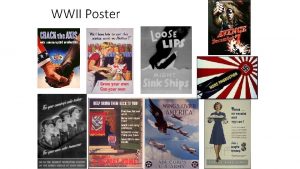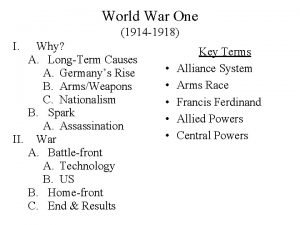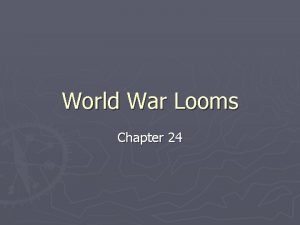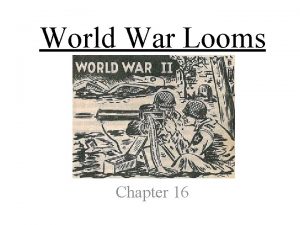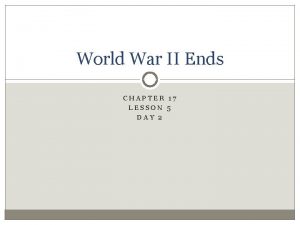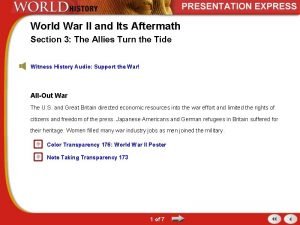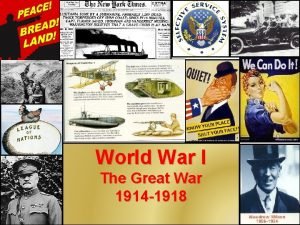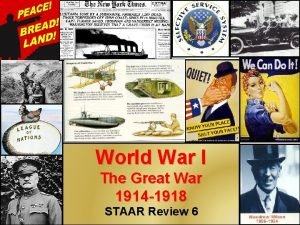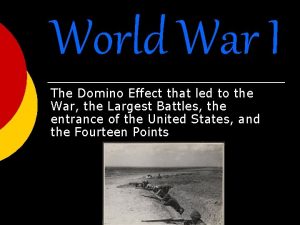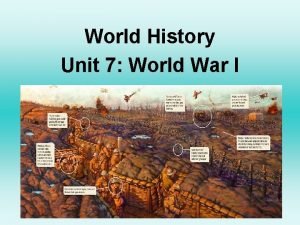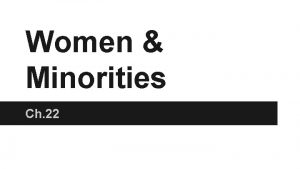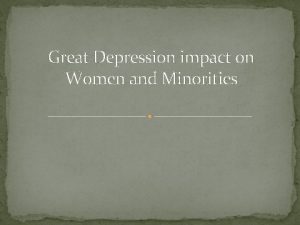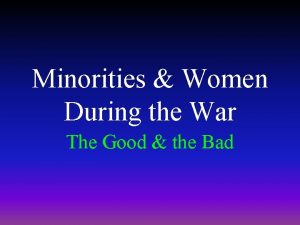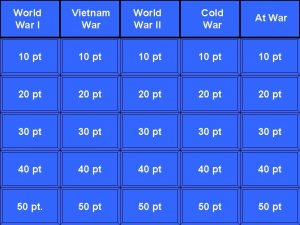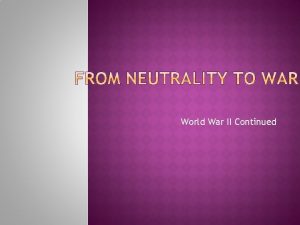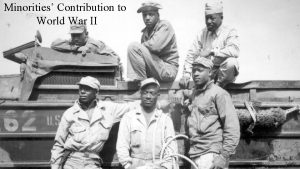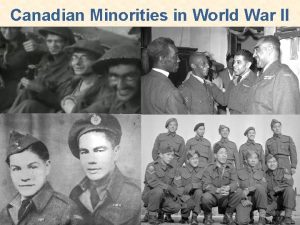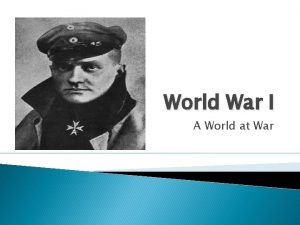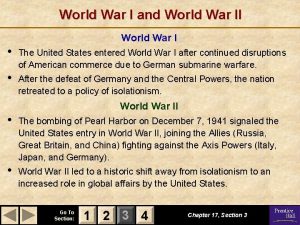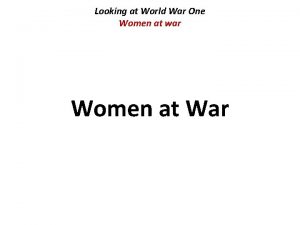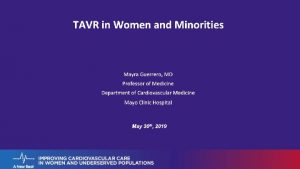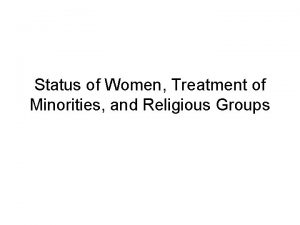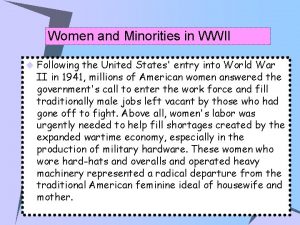IMPACT OF WORLD WAR II ON WOMEN MINORITIES



































- Slides: 35

IMPACT OF WORLD WAR II ON WOMEN & MINORITIES

THE UNITED STATES

IMMIGRANTS & MIGRATION Millions of Italian Americans and German Americans supported the war program Patriotism speeded assimilation of many ethnic groups Italian and German Americans faced some job discrimination and social prejudice War industries drew Americans into boom towns like Los Angeles, Detroit, Seattle, and Baton Rouge


JAPANESE AMERICANS Issei- first generation – those born in Japan but now living in the U. S. Nisei- second generation– the American born (CITIZENS!!!!) children of Japanese immigrants Brought underlying racism to the surface through harassment, prejudice, and eventual stripping of their rights as citizens Feared they were being used as spies

EXECUTIVE ORDER 9066 (FEBRUARY 19, 1942) Forcibly placed Japanese Americans living on the West Coast in concentration camps Disrupted the lives of 112, 000 Americans 2/3 of those in camps were American citizens (nissei) Deprived citizens of their rights Cost hundreds of millions in lost property and earnings Korematsu v. U. S. (1944) Upheld the constitutionality of the internment camps Civil Liberties Act of 1988 Paid surviving internees $20, 000 each as a symbolic reparation for their hardship

ANSEL ADAMS PHOTOS OF LIFE IN INTERNMENT CAMPS




DOROTHEA LANGE INTERNMENT PHOTOS These photos are taken at the San Bruno, California Camp and Manzanar




TOYO MIYATAKE Acclaimed Japanese American photographer Evacuated to Manzanar Internment Camp Only documentation of daily camp life by an internee Video Link http: //www. npr. org/sections/codeswitch/2016/02/17/466453528/ photos-three-very-different-views-of-japanese-internment

WOMEN IN THE ARMED FORCES 216, 000 enlisted for non-combat duties WAC’s – Women’s Army Auxiliary Corps WAVES– Women Accepted for Volunteer Emergency Service (Navy) SPARS– U. S. Coast Guard WASPS– Women’s Airforce Service Pilots More than 1000 served First women to fly military aircraft Did not receive full military status until 1977


ROSIE THE RIVETER Most iconic image of the war Aimed at recruiting female workers for the munitions industry http: //www. history. com/topics/worl d-war-ii/world-war-iihistory/videos/ask-history-rosie-theriveter? cmpid=mrss_int_taboola_vi deo_his

NATIONAL ROSIE THE RIVETER DAY March 21, 2017 National Rosie the Riveter Day Effort to raise awareness of women’s efforts in WWII

WOMEN IN INDUSTRY 6 million women entered the workforce Government established 3000 daycare centers to care for “Rosie’s” children Producing planes and munitions, working in shipyards, and producing other equipment vital to the war effort


IMPACT OF WAR ON WOMEN 2/3 of working women left at war’s end Many continued to work foreshadowing the revolution of women’s roles in American society Widespread rush into suburban domesticity and the mothering of the “baby boomers” who were born in the tens of millions from 1945 -1960

AFRICAN AMERICANS 1. 6 million blacks fled the South Race relations became a national issue A. Philip Randolph (head of the Brotherhood of Sleeping Car Porters) threatened a massive “Negro March on Washington” in 1941 to demand equal opportunities for blacks in war jobs and the armed forces Roosevelt’s response – Executive Order forbidding discrimination in defense industries Fair Employment Practice Committee was created to monitor compliance NAACP membership shot up to half a million Congress of Racial Equality (CORE) founded in 1942

AFRICAN AMERICANS IN MILITARY SERVICE Blacks drafted into armed forces Service branches rather than combat units Faced degradation in housing, service, and even segregated blood banks Rallied behind “Double V”- victory abroad and over racism at home NAACP membership shot up to half a million Congress of Racial Equality (CORE) founded in 1942

TUSKEGEE AIRMEN All African-American pursuit squadron based in Tuskegee, Alabama in 1941 Army Air Corps program to train African Americans to fly and maintain combat aircraft Included 996 pilots, navigators, bombardiers, maintenance and support staff, instructors, and more than 15, 000 personnel who kept the planes and pilots in the air The Tuskegee Institute became the center for African-American aviation during WWII. Their exemplary service opened the door for the racial integration of the military services

NATIVE AMERICANS Mass exodus from reservations Thousands found work in major cities In 1940, 90% lived on reservations by 2000 more than half lived in cities 25, 000 joined the Armed Forces Comanches in Europe and Navajos in the Pacific made valuable contributions as “Code Talkers”

MEXICAN IMMIGRANTS Bracero Program Brought thousands of Mexican agricultural workers to harvest fruit and grain crops of the west Program outlived war by 20 years and established a pattern of immigrants as agricultural workers in the American West.

WOMEN AND MINORITIES IN CANADA Canadian Women’s Army Corps arriving in Sicily 1944

IMMIGRATION Prior to World War II, Canada did not want any more immigration coming into the country Some immigrants were even rounded up and deported The Liberal Party relied on immigrant voters (were thought to have supported immigration)

JEWS Director of Immigration (Fred Blair) Anti-Semite who held office as Hitler was announcing his plan for the Jews Jewish refugees were not allowed in Canada French-Canadians made sure Anti-Semitism was prominent throughout Canada (created quotas for admission into Mc. Gill University, unable to attend certain beaches, clubs, and resorts) Most Jews were viewed as being clever yet vulnerable, were humbly employed due to being new immigrants Achat Chez Nous Movement: movement of the 1930 s that was instituted by the Catholics of Quebec to boycott all Jewish stores/businesses, therefore making Jews leave (Jews only made up about 1% of Quebec’s population)

THE ST. LOUIS • German liner carrying 907 German Jewish refugees with visas for Cuba in 1939 • No country in the Americas would let them in. • 254 of these would die in the Holocaust

WOMEN When war broke out, men and women volunteered for service but due to the gender roles and environment in Canada, men had a much higher enlistment number than women. Women were asked to replace men in civilian jobs when they went off to war In colleges throughout Canada, women stopped attending classes on “knitting” and started doing their part in driving Red Cross trucks By 1944, 30% of non-agricultural workers were women By the end of the war, the question was would women leave the men’s workplace quietly and happily—some did, some did not.


OTHER MINORITIES Chinese, Japanese-Canadians, and South Asian immigrants were viewed as inferior and unable to assimilate in Canadian society The attacks at Pearl Harbor only ignited the violence and hatred of Japanese-Canadians; some were forced to relocate from their homes more inland still faced racial prejudice then Both German-Canadians and Italian-Canadians faced discrimination prior to and during the war

UNITED NATIONS When Canada joined the UN, their racial prejudices was brought to light After much discussion, Asians were finally given the vote in Canada and the ban on immigration was lifted
 Chapter 7 lesson 4 the war's impact
Chapter 7 lesson 4 the war's impact Rachel kimery
Rachel kimery Sandy allen height
Sandy allen height How did the great depression impact the world
How did the great depression impact the world Impact of neo colonialism on third world countries
Impact of neo colonialism on third world countries How did the mongols positively impact the world
How did the mongols positively impact the world James madison war at home
James madison war at home Description
Description The cold war begins lesson 1
The cold war begins lesson 1 Presidential and congressional reconstruction venn diagram
Presidential and congressional reconstruction venn diagram Why did josette dugas want to go to war
Why did josette dugas want to go to war Sein datid
Sein datid Force and motion study jams
Force and motion study jams Why was the civil war the first modern war
Why was the civil war the first modern war Ich war du warst er sie es war
Ich war du warst er sie es war Chapter 16 lesson 2 challenges to slavery
Chapter 16 lesson 2 challenges to slavery Sides of cold war
Sides of cold war Chapter 30 the war to end war
Chapter 30 the war to end war Chapter 30 the war to end war
Chapter 30 the war to end war Which persuasive technique is used in this poster
Which persuasive technique is used in this poster Results of the world war 1
Results of the world war 1 Chapter 24 building vocabulary world war looms
Chapter 24 building vocabulary world war looms Chapter 16 building vocabulary world war looms
Chapter 16 building vocabulary world war looms Lesson 5 world war 2 ends
Lesson 5 world war 2 ends World war 2 and its aftermath section 1 quiz
World war 2 and its aftermath section 1 quiz What was the immediate cause of world war i brainpop
What was the immediate cause of world war i brainpop Chapter 27 world war 1 and the russian revolution
Chapter 27 world war 1 and the russian revolution Zimmerman telegram
Zimmerman telegram 4 causes of wwi
4 causes of wwi What was the cause of world war 1
What was the cause of world war 1 M.a.i.n. causes of ww1
M.a.i.n. causes of ww1 Ww1 domino effect
Ww1 domino effect Chapter 27 lesson 4 world war 1 ends
Chapter 27 lesson 4 world war 1 ends Total war world history definition
Total war world history definition Triple entente countries in world war 1
Triple entente countries in world war 1 What is a thesis statement
What is a thesis statement



















